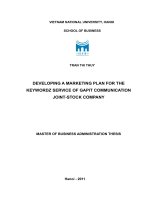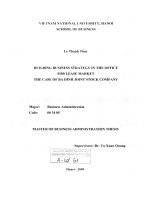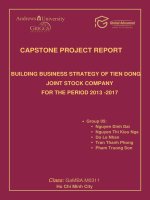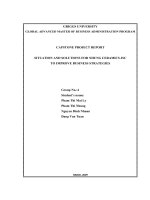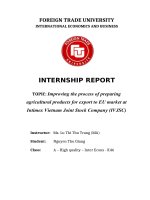The perceived value of estore EATDELI towards online purchasing: The case of UboFood Vietnam Joint Stock Company
Bạn đang xem bản rút gọn của tài liệu. Xem và tải ngay bản đầy đủ của tài liệu tại đây (2.99 MB, 54 trang )
..
THUONG MAI UNIVERSIY
INTERNATIONAL TRAINING INSTITUTE
~~~~~o0o~~~~~
INTERNSHIP REPORT
TOPIC: The perceived value of e-store EATDELI
towards online purchasing: The case of UboFood Vietnam
Joint Stock Company
MAJORS: E-COMMERCE AND DIGITAL MARKETING
Supervisor
:Dr. LE Xuan Cu
Full name
:NGO Thi Hai Yen
Student Code
:19K610127
Class
:CN16-ECO2
Hanoi, 2022
ABSTRACT
The Vietnamese-commerce market has been developing quickly, especially since
2013. This development benefits businesses and creates fierce competition to retain
old customers. As people's lives are increasingly upgraded, their desired benefits also
change. Perceived benefit aspects are increasingly concerned and valued by customers
about their behavior. The relationship between internal motivations such as spiritual
benefits, trust, perceived recreational value anxiety, and loyalty behavior of customers,
especially for emerging markets like Vietnam.
This study aims to better understand the perceived benefits of customers and the
manifestations of loyalty in the context of online shopping in Vietnam and, at the same
time, study the influence of anxiety on customer relationships. Relationship between
perceived mental benefits, online trust, recreational value, and online loyalty.
Qualitative research is used to develop the scale and adjust the scale and Quantitative
analysis is aimed at testing the scale and testing the research hypothesis. At the same
time, this study also makes practical contributions to e-commerce businesses in the
Vietnam market through suggestions to help companies to improve customer loyalty.
“Improve customer perceived value” has a strong relationship with loyalty and
repurchase behavior about a product or service. Customers with good perceived value,
satisfaction with the product, and the ability to use it will be high. However, online
stores as a potential category in Vietnam customers were down in 2015, which means
customers also have more choices. Therefore, businesses need to provide many
benefits to customers to attract new customers and retain old customers. The study
aims to provide a solution to improve the perceived value of the EatDeli online store
for online food shopping behavior.
i
ACKNOWLEDGMENTS
Through my internship at UboFood Joint Stock Company, Hanoi, working in a
good environment, I have learned a lot from practical experience and specialized
terms. I chose the e-store EatDeli project - a new project under development as my
internship site and gained valuable experience after my internship at the company.
Although the time was not long, it was enough for me to contact and apply the
knowledge I heard and was taught from the school in real life, helping me have a
broader and more objective view of the food industry. And thereby help me clearly
define myself, my goals, and my path in the future. During my internship at the
EatDeli project, I received much help from my colleagues to have the best internship
conditions. Also, during my internship here, I faced many difficulties because the
theory at school and the reality of work were quite different. However, thanks to the
support of my colleagues, I overcame those difficulties and strengthened my skills,
self. Theoretical knowledge learned in school. I find it essential to understand
customers and give them new experiences as a marketer. So, I had new ideas to handle
these issues and consulted with management to develop more appropriate and practical
solutions to bring customers unique experiences and experimental values to continue
to support the project we are developing.
I want to thank the teachers of the University of Commerce for directly teaching
and imparting helpful knowledge - the basic foundation, which is the first step for me
to step into my future career firmly. Especialy, I would like to thank my supervisor Le
Xuan Cu - who enthusiastically guided, edited, and commented on my report from
drafting to completion. Thanks to that, we were able to complete this graduation thesis.
Furthermore, I want to thank the Board of Directors of UboFood for giving me a
valuable opportunity to practice here and for providing information to complete this
research. Finally, I would like to thank everyone in the marketing department who
enthusiastically helped me during my internship at the company. After almost three
months of internship, I think it is a precious time for me to accumulate knowledge. I
hope the solutions I gave during the internship will be applied in practice and benefit
the EatDeli project.
ii
TABLE OF CONTENTS
ABSTRACT i
ACKNOWLEDGMENTS
ii
TABLE OF CONTENTS iii
LIST OF FIGURE vi
LIST OF ACRONYMS
vii
CHAPTER I: INTRODUCTION
1
1.1. CONTEXT AND JUSTIFICATION OF THE RESEARCH............................1
1.2. RESEARCH OBJECTIVE.................................................................................1
1.3. SCOPE OF THE RESEARCH...........................................................................2
1.4. METHODOLOGY..............................................................................................3
1.4.1. Data collection methods.....................................................................................3
1.4.2. Data processing method.....................................................................................4
CHAPTER II: LITERATURE REVIEW
6
2.1. THE BASICS OF PERCEIVED VALUE..........................................................6
2.1.1. Definition of perceived value.............................................................................6
2.1.2. The role of perceived value................................................................................7
2.1.3. Measuring customer perceived value................................................................8
2.1.4. Elements of customer perceived value..............................................................9
2.2. HYPOTHESES DEVELOPMENT..................................................................10
2.2.1. Relationship between perceived value and customer satisfaction..................10
2.2.2. Relationship between Customer Perception of Service Quality and Customer
Perceived Value...........................................................................................................11
2.2.3. Relationship between Customer Satisfaction and Repurchase Intention.......12
2.3. PROPOSING A RESEARCH MODEL...........................................................13
CHAPTER III: UBOFOOD VIETNAM JOINT STOCK COMPANY: RESEARCH
OF THE FIELD VALUE OF EATDELI ELECTRONICS STORE 14
3.1. OVERVIEW OF UBOFOOD JOINT STOCK COMPANY..........................14
3.1.1. History of formation and development............................................................14
3.1.2. Organizational structure..................................................................................15
iii
3.2. BUSINESS PERFORMANCE.........................................................................18
3.3. MARKET AND CUSTOMERS.......................................................................19
3.3.1. Market of Ubofood company...........................................................................19
3.3.2. Customer Of Ubofood Company.....................................................................20
3.4. DESCRIPTION OF THE COMPANY’S PRODUCTS AND MARKETS....20
3.4.1. Products and services.......................................................................................20
3.5. OVERVIEW OF THE EATDELI PROJECT OF UBOFOOD COMPANY 21
3.6. MAIN ANALYSIS MEASUREMENT ASSESSMENT..................................22
3.6.1. About the company’s website...........................................................................22
3.6.2. Mobile Application...........................................................................................23
3.7 EVALUATION OF THE PERCEIVED VALUE OF THE E-STORE EAT
DELI ........................................................................................................................ 24
3.7.1. Current status of functional factors................................................................24
3.7.2. Current status of Epistemic Value factor.........................................................25
3.7.3. Current status of the emotional value factor...................................................26
3.7.4 Current status of the social value factor..........................................................27
CHAPTER IV: CONCLUSIONS AND SOME SOLUTIONS TO ENHANCE
THE FEELING VALUE FOR E-STORE EAT DELI
32
4.1. CONCLUSIONS...............................................................................................32
4.1.1. Successes have been achieved.........................................................................32
4.1.2. Unresolved problems........................................................................................32
4.1.3. Cause of existence...........................................................................................32
4.2. SOLUTIONS TO ENHANCE THE PERCEIVED VALUE OF THE ESTORE EAT DELI....................................................................................................33
4.2.1. Solution about function value factor...............................................................33
4.2.2. Solution about Epistemic Value factor............................................................35
4.2.3. Solution about emotional value factor............................................................35
4.2.4. The solution to the social value factor.............................................................36
4.3. DISCUSSION....................................................................................................38
REFERENCES
APPENDIX
iv
v
LIST OF TABLES
Table 3.1. The organizational structure of Ubo Food Vietnam Joint Stock Company..17
Table 3.2. The company’s revenue table from 2019-to 2021.......................................18
Table 3.3. First capital table at Ubo Food from 2019-2021 (unit: VND).....................19
vi
LIST OF FIGURE
Figure 2.1. The formula for measuring perceived value................................................8
Figure 2.2. Proposed research model..........................................................................13
Figure 3.1. The organizational structure of Ubo Food Vietnam Joint Stock Company 15
Figure 3.2. EatDeli e-store homepage..........................................................................22
Figure 3.3. List of “Prepared foods.”...........................................................................23
Figure 3.4. The interface on the mobile application.....................................................23
Figure 3.5. Ordering form used by the customer.........................................................25
Figure 3.6. When customers choose to order...............................................................26
Figure.3.7. Satisfaction level of customer service staff................................................26
Figure 3.8. Difficulties encountered when buying goods.............................................27
Figure 3.9. The interface of fanpage on social network Facebook of e-store Eat Deli........28
Figure 3.10. Summary of Eat Deli Fanpage from April 27 to May 24.........................29
Figure 3.11. OA interface on Zalo social network of e-store Eat Deli.........................30
vii
LIST OF ACRONYMS
Numbers
Acronyms
Meaningful
1
CPV
Customer Perceived Value
2
R&D Dept:
Research and Development
3
OA
Office Account
4
P.R
Public Relations
viii
CHAPTER I: INTRODUCTION
1.1. CONTEXT AND JUSTIFICATION OF THE RESEARCH
Due to the increasing influence of the Covid-19 epidemic and the growing
popularity of social networks and mobile internet access, social media marketing is
becoming an important channel through which businesses trade. Will boost investment
in e-commerce in the coming years. In Vietnam, 77% of survey respondents said that
they regularly learn more about different product groups while surfing the web and
using social networks. 79% said they would try new brands when shopping for food
and fashion items. The multi-channel shopping experience is significant to Vietnamese
users, especially in the context of the current epidemic. 82% of online shoppers say
they research what they want to buy online. Even while in-store, 39% of shoppers will
turn to a review on social media.
Online shopping services increasingly occupy an essential position and are
considered the focus of e-commerce activities. According to economists, the online
retail sector brings high revenue, solid development, and low risk. Along with the
potential of a young population, extensive use of social networks, and a large
population, the current demand for clean food sources in Hanoi and across the country
is vast; almost everyone has a need. Consumers’ shopping habits and behaviors will
change in the rapidly changing consumption trend, and where will they choose to shop
between the traditional market and the online store? The following research provides
solutions to improve customers’ perceived value of the EatDeli e-store.
According to AhmadRezaAsadollahi et al. (2012), “Analysis of factors affecting
consumers’ intention to shop online can be one of the most critical e-commerce and
marketing field issues.” The study uses a model that examines the influence of
perceived risk, facility, and returns policy on attitudes towards online shopping
behavior and subjective norms, perceived self-esteem. Ownership in behavior, specific
creative domains, and attitudes about online shopping behavior.
1.2. RESEARCH OBJECTIVE
The study was carried out to achieve the following objectives:
Firstly: Determining the components of customers’ perceived value of service
quality at EatDeli
1
Secondly: Analysis of the current situation of factors constituting customer's
perceived value of service quality at EatDeli
Thirdly: Proposing several solutions to improve customers’ re-purchase intention,
thereby enhancing perceived value, improving customer satisfaction, creating a
superior competitive advantage, and attracting and retaining customers using online
food shopping services at EatDeli
Since the online shopping process is gaining more and more attention, especially
in the food industry, researching customers’ perceived value for the e-store EatDeli
improves consumer value and service quality. Hence, the objective of this study was to
reveal the possible relationship between the dimensions of the perceived value model
and online purchase intention. Furthermore, it was anticipated that the statistical
determination of probably perceived values as the basis for online purchase intention is
essential for the research field of consumer behavior and e-commerce. Specifically,
this study will deepen knowledge about the values influencing consumer intention in
online shopping. Accomplish the goal; this article will illustrate the theoretical
background and survey customers ordered at EatDeli. This research will then provide
recommendations to help enhance customer value and build trust when consumers
place an order at EatDeli.
1.3. SCOPE OF THE RESEARCH
This current study proposes solutions to enhance the perceived value when
customers have an online food shopping experience at the website EatDeli Fanpage
and the factors affecting the customer’s perceived value.
The scope of research is limited to Hanoi as it is the capital city of Vietnam;
EatDeli is new and focuses on consumers in the inner city districts of Hanoi. In
addition, Hanoi is one of the food consumption areas and has the leading demand for
clean food in the country. Therefore, people living in this largest urban area will have
full knowledge of products of organic origin and have high requirements for food
hygiene and safety. Moreover, EatDeli focuses on homemakers, and office workers are
suitable for this study because they usually don’t have much time to go to the
traditional market. To surf the web and order online.
2
Spatial range
The topic was studied at the Eat Deli e-store project of Ubofood Vietnam Joint
Stock Company.
Time range
During the internship period, report and thesis writing. In addition, to draw
objective conclusions, the author studies the situation of customers’ perceived value
with the Eat Deli project at Ubo Food Vietnam Joint Stock Company through the
following data: Financial statements, Newspapers Business results reports, research
papers, written documents updated from 2019 to May 2022
1.4. METHODOLOGY
1.4.1. Data collection methods
Secondary data collection method
Secondary data is collected from two data sources inside and outside the
company to serve the research topic as the basis for the topic analysis:
Internal data sources: Business activity reports, website performance, forms to
increase customer service efficiency, personnel situation, and financial statements.
External data sources: Referenced from lectures and textbooks related to the
perceived value of the Thuong Mai University. Documents searched on the Internet
through reputable websites related to e-commerce and perceived benefits to customers.
In addition, information is also searched through forums, articles at the library, and
articles in electronic newspapers or magazines.
Primary data collection method
Primary data is not yet available, collected for the first time, and organized by the
researcher. The preliminary data will help to solve urgent and timely problems. In
addition, primary data is directly collected, so the accuracy is higher. In this study,
primary data was collected through a customer survey.
Survey content: The questionnaire is a multiple-choice question related to
customers’ perceptions, understanding, and evaluations of service attitudes and quality.
From there, learn about the status of customers’ feelings towards the Eat Deli e-store.
The investigation aims to collect reviews from customers about the company’s
service provision status. From there, evaluate the effectiveness of the operation and
offer a reasonable solution.
3
Objects of investigation: The questionnaire is a simple multiple-choice question
for customers who regularly order from the company.
Form of investigation: Building a survey form with multiple-choice questions
related to the research problem. Build and distribute 30 questionnaires to customers,
then collect and analyze.
Advantages: Interviewing customers who have bought products of the company
the subject is researching, thereby exploiting the results with high accuracy.
Disadvantages: It is difficult to get an overview and objective assessment of the
market and the company’s sales management process. Requires researchers to be able
to analyze and select answers.
1.4.2. Data processing method
Qualitative research
They were conducted by the focus group discussion method to supplement and
correct the scale of perceived value components.
Synthetic-inductive methods are two complementary methods. The synthetic
approach focuses on presenting facts and explaining them causally. The inductive
approach shows the relationship between the points and forms the rule.
The dramatic method is the method from which a rule gives specific examples.
This method is beneficial for testing theories and hypotheses. The purpose of this
method is to conclude. The conclusion must necessarily follow the given reasons.
These reasons lead to conclusions and are demonstrated through specific examples.
Quantitative research
A quantitative method is a systematic empirical investigation of observable
phenomena through statistics, mathematics or numbers, or computer engineering. It
deals with relationships in theory and research from a deductive point of view.
In this topic, the data is synthesized and analyzed through Microsoft Office
software, with the tool used directly here is an Excel spreadsheet. This is the most
widely used spreadsheet program. In Excel, several tools allow users to conduct
statistical data analysis. Excel can organize data, present data, tabulate, graph, and
analyze data statistics. Finally, data after being aggregated, statistics, classified, and
selected will be analyzed to conclude.
4
In addition, the study also applies descriptive, synthetic, and comparative
statistical methods to analyze the current situation of factors constituting the perceived
value of customers of EatDeli’s online food shopping service.
Investigative method: Build a questionnaire with multiple-choice questions
related to the research problem. Build and issue customer surveys (60 survey ballots),
then collect and process information and data.
How to proceed?
Step 1: Determine the objectives and content to be researched.
Step 2: Design the questionnaire: Multiple choice questions related to the topic.
Step 3: Send the questionnaire after design to customers who have purchased
through the online food exchange Eat Deli; the questionnaire after the customer has
answered will be aggregated and processed data.
Step 4: Handling: Select honest and correct questionnaires, and remove invalid
votes. Synthesize and process data from which to draw comments and conclusions.
Distributing survey form: 90 ballots
Valid count: 53 votes
Number of votes collected: 55 votes
From those data, data processing, and analysis, conclusions are made.
5
CHAPTER II: LITERATURE REVIEW
2.1. THE BASICS OF PERCEIVED VALUE
2.1.1. Definition of perceived value
According to Zeithaml (1988), perceived value is a consumer’s overall
assessment of the utility of a product or service based on their perception of what is
received and what has to be spent. According to Monroe (1990), buyers’ perception of
value describes the balance between the product quality or the benefits they perceive
from the product and the cost they pay for the product. Butz & Goodstein (1990) argue
that customer perceived value is the emotional relationship established between the
customer and the supplier after the customer has used a product or service of the
supplier and finds that the product or service creates added value.
According to Anderson, Jain & Chintagunta (1993), customer perceived value is
the perceived monetary value of the technical, economic, service, and social benefits
that customers can expect. Received compared to the price they pay for a product,
considering the costs and offers of available suppliers.
Gale (1994) states that customer perceived value is the perceived quality of the
price paid for that product. It is the customer's opinion of a company’s product or
service compared to a competitor’s product or service.
According to Cronin et al. (1997), perceived value is the combination of service
quality and its benefits (functional, social, economic benefits) and sacrifices (time,
effort, money) that an individual must pay to obtain services. It is also based on
experiences from services received.
According to Woodruff (1997), customer perceived value is the customer's liking,
perception, and evaluation of the product’s features, the performance of the part, and
the results achieved (or consequences arising) from such use facilitate the achievement
of the customer’s goals and objectives in the use cases.
In short, the customer’s perceived value is the difference between the total value
received and the total cost paid. Total perceived value is the benefits consumers expect
from a product or service. Total costs are all the costs consumers pay in comparing,
purchasing, and using a product or service.
2.1.2.
The role of perceived value
6
a. Perceived value and customer choice
In essence, the business activities of enterprises are exchanged exchange. Bartering
is one of four ways to obtain products (self-production, coercion, begging, and barter).
Bartering is getting the desired outcome from someone by giving them something that
suits their need. Exchange occurs when the following conditions are met:
There must be at least two sides.
Each party must have something of value to the other.
Each party must deal with and deliver its goods.
Each party has the right to accept or reject the proposal from the other party.
Each party is convinced that it wants or doesn’t want to deal with the other
party.
Therefore, communication is seen as a process, not an event. Two parties are
considered to have entered into an exchange if they negotiate to agree. How will
consumers choose when deciding to trade among the many products and services that
can satisfy a specific need? According to economic theory, people always try to
maximize utility or utility. Maximization is derived from the fact that consumers can
choose between substitute products. Not surprisingly, when costs and benefits are
closely related, they constitute the customer’s perceived value. They are the criteria to
judge whether a product or service is worth it. Thus, from an economic point of view,
consumers can use a cost-benefit relationship when weighing the value of a product or
service. Therefore, customer value assessment is the basis for purchasing decisions.
According to previous research, perceived value is also the most critical factor
affecting customers’ purchase intention and loyalty.
Grewal & Ctg assert that customer value is a good predictor of repeat purchases
and loyalty. The inherent perception of customer value increases willingness to buy
and reduces their search intention. And the key to enhancing customer choice and
commitment is to bring them the highest value.
b. Perceived value and competitive strategy of the company
Customer’s perceived value determines consumers’ choice of products/services
and their loyalty. Therefore, perceived value will determine the success of a
competitive strategy.
7
Competition is not a war of products. It's the war of awareness. However, many
people think of competition as a war of products. In the long run, they expect the best
product to win. There are no best products.
All that exists in the competitive world are perceptions in the customer’s mind.
The sense of the customer is difficult to change. Consumers assume they are suitable
with some experience in a product category. Therefore, competition is not about
competitors but customers bringing outstanding values. Only by providing a great deal
will the company’s products be chosen by customers. Businesses will attract, win, and
retain customers and increase their market share and profits.
Therefore, businesses must understand how customers perceive the value for
customers they provide through their products and services to build an appropriate
competitive strategy. Values customers expect to guide the company's decisions about
products and investments in satisfying customers. Customer insight is the foundation
of a common strategic framework within which activities are designed and built to
deliver superior value to target customers.
2.1.3.
Measuring customer perceived value
Customers often value a product’s benefits above its functionality when
purchasing. For example, a customer buys a computer not simply to have a computer
but because he is interested in the value and benefits that the computer brings to him.
Instead, customer perceived value can be determined by the relationship between
perceived benefits and perceived costs:
Perceived
Benefits
Customer
Perceived
Value
(CPV)
Customer
Perceives
Costs
Figure 2.1. The formula for measuring perceived value
Source: Concepts and Marketing
The CPV is an evaluation done by a customer on what value a product or a
service would be able to provide if they buy it by paying money.
Note: the benefits and costs also include the emotional benefits and costs.
8
2.1.4. Elements of customer perceived value
According to Sheth et al. (1991), perceived value consists of 5 elements:
a. Functional Value
According to Ok-Kim and Jin (2001), the perceived function can be considered a
reflection of shopping efficiency, which is the degree of convenience and speed to
access the desired product. Shopping or buying online is the most appropriate method
to accept and exchange offers in terms of convenience and speed. Many scholars have
suggested that internet retailing is more convenient (Hsin Chang & Wang, 2011) and
more time-saving (Lee, Eze, & Ndubisi, 2011) to obtain the desired product or service.
compared to traditional shopping methods. Because online shopping is efficient, the
value was enhanced in terms of functionality compared to traditional shopping
(Pavlou, 2003). Therefore, the functional value of internet usage can increase
consumers’ intention to purchase online in larger quantities.
Refers to customers’ economic benefits derived from attributes of products and
services (features, utilities, etc...).
b. Epistemic Value
According to Ok-Kim and Jin (2001), the perceived function can reflect shopping
efficiency, the degree of convenience, and the speed to access the desired product.
Shopping or buying online is the most appropriate method to accept and exchange
offers in terms of convenience and speed. Many scholars have suggested that internet
retailing is more convenient (Hsin Chang & Wang, 2011) and more time-saving (Lee,
Eze, & Ndubisi, 2011) to obtain the desired product or service. compared to traditional
shopping methods. Furthermore, because online shopping is efficient, the value was
enhanced in terms of functionality compared to traditional shopping (Pavlou, 2003).
Refers to the benefits obtained through providing new features or arousing the
curiosity and creativity of customers to meet the needs of knowledge development.
c. Emotional Value
The emotional response is a descriptive judgment about the pleasure a product or
service provides to the buyer (Parasuraman & Grewal, 2000; Sweeney et al., 1998).
Crosby & Johnson (2005) asserts that solid emotions toward a product/service are
integrated so that customers are loyal and can build a high barrier for competitors to
9
overcome. According to Sheth et al. (1991), emotional value evokes psychological or
emotional states for customers through the service provider’s service.
Refers to the values related to emotions or emotional state, happiness, and
sadness when buying products or services and impressions of customers in consuming
products and services.
d. Social Value
According to Sheth et al. (1991), Social value is the approval and appreciation of
a group of people in society to affect someone when this person uses products or
services; Social value refers to the fit between the image that others think of the
customer and the idea that the customer wants to achieve. Social values are considered
personal beliefs, social integration, and recommendations of relatives or friends
(Neringa et al., 2012).
Social value: Refers to social benefits, that is, the value recognized by customers,
appreciated, or entered into social relationships.
e. Conditional Value
Conditional value derives from a specific situation or context of a purchasing
decision (Long & Schiffman, 2000). The measurement of dependent value involves a
set of choice contingencies. Conditional value refers to situational contingencies
contributing to temporary functional and social utility (Pope, 1998). This situation may
influence a consumer's decision-making process. For example, income, a stock-out
case, and fashion could manipulate a consumer's purchasing decision-making process.
Several lines of inquiry have influenced conditional value. These have recognized the
importance of learning due to experiencing a given situation (Pihlström & Brush,
2008). Any consumer purchase intention is greatly affected by the consumer’s
situation because different conditions impact their final decision. Therefore, retailers
should create a favorable position to increase consumers' intent to purchase online.
2.2. HYPOTHESES DEVELOPMENT
2.2.1. Relationship between perceived value and customer satisfaction
Customer satisfaction compares what customers expect and what they get from
the service. It is essential to clearly distinguish customer perceived value from
customer satisfaction because many individuals and organizations get confused
10
between the two concepts. This is entirely understandable because: firstly, most
organizations are now familiar with using the concept of customer satisfaction to know
the customer's evaluation of their product or service. Both customer perceived value
and customer satisfaction represent the customer's response to a product or service.
Although easy to confuse, these two concepts are different. A customer may be
satisfied with a product or service, but that does not mean that the value of that product
or service is perceived as high. This is possible when a customer is delighted with the
service but considers its value low if its cost is too high. Customer satisfaction is the
assessment of customer feedback after purchase (Sanchez et al., 2006), while customer
perceived value is developed before, during, and after purchase (Sweeney & Soutar,
2001). Therefore, customer perceived value appears at different stages of the buying
process, while customer satisfaction occurs only after purchase. According to
Woodruff & Gardial (1996), customer satisfaction is customers' negative or positive
perception about the value they receive when using a product or service.
Thus, perceived value is a factor that directly affects customer satisfaction, and
customer satisfaction is the result of customer perceived value. As a result, they are
closely related even though they are two different concepts, they are closely related. In
short, studying customer perceived value will tell the organization what to create and
what to do, while customer satisfaction will help the organization evaluate how it is
performing.
2.2.2. Relationship between Customer Perception of Service Quality and
Customer Perceived Value
As mentioned above, professional services have a high quality of experience and
reliability. This is due to frontline employee characteristics such as expertise,
interpersonal skills, customer orientation, technical skills, and understanding of
customer needs.
Customers are all considered buyers, according to Day and Barksdale (1992),
Murali and Muralidharan (2016), and Bolzani (2018). This requires organizations to
select employees from a talent pool with the necessary specialized technical and
technical skills.
11
In business interactions. Several researchers, such as Garavan (1997), Hurrell and
Scholarios (2014), and Utkarsh (2018), have stated that consistent, high-quality
interactions require staffing, development, and training as a prerequisite. Develop
interpersonal communication skills. These same researchers also claim that the
knowledge that frontline workers have and how to use technology can lead to
customers seeing a service as valuable, according to Breidbach and Srinivasan (2013).
Furthermore, previous research has discovered a significant relationship between
correlated value with customer satisfaction and perceived service quality (Brady and
Cronin, 2001; Jiang and Cardinali), 2018). These researchers suggest that service
providers need to consider potential changes to provide solutions and meet customer
needs, which will add value to the service from the point of view. of the customer.
In the context of studies focusing on the relationship between CPV and service
quality, the study of Cronin et al. (2000) and Bauer et al. (2006) indicated that service
quality has a positive impact on perceived value. Therefore, considering these
variables, the four service quality-related variables encapsulated in the conceptual
model are positively correlated with the effects caused by the positive relationship
with CPV. As a result, the following hypotheses are proposed:
H1a, H2a, H3a, H4a: Customers' perception of the company's service quality in
general includes (1a) interpersonal communication skills, (2a) technical skills, (3a)
technology, and (4a) reliability is positively related to customer perceived value.
2.2.3. Relationship
between
Customer
Satisfaction
and
Repurchase
Intention
Oliver (2014) and Nagengast et al. (2014) support the view that there is a positive
relationship between behavioral intention and satisfaction. In addition, Bufquin et al.
(2017) indicate that behavioral intentions are often encapsulated in repurchase
intentions. Many researchers, such as Brady et al. (2001), Cronin et al. (2000), and
Johnson and Fornell (1991), consider satisfaction as a relationship between repurchase
intention and customer satisfaction that is intrinsically positive. Furthermore, Zeithaml
et al. (1996) reported that highly satisfied customers are generally more likely to
recommend a product and intend to repurchase the product in question. To be more
12
precise, improved customer satisfaction increases repurchase intention. In addition,
they stated that the link between.
These two factors are favorable. In addition, research by Cronin and Morris
(1989), Cronin and Taylor (1992), Anderson and Sullivan (1993), Gotlieb et al. (1994),
Patterson et al. (1997), and Lajevardi (2014) also showed that there is a positive
relationship between repurchase intention and satisfaction. We then hypothesize 7a:
H7a: Customer satisfaction has a positive effect on repurchase intention.
2.3. PROPOSING A RESEARCH MODEL
The proposed research model is mainly based on the Zeithaml (1988) model and
the SERVPERVAL scale of Petrick (2002). In Vietnam, researchers also apply this
model to measure the perceived value of different types of services.
Conditional Value
Espimieds Value
PERCEIVED
VALUE
Epistemic Value
Emotional Value
Social Value
Figure 2.2. Proposed research model
Source: Proposal of the researcher
Petrick (2002) has developed a perceived value scale for SERV-PERCIVAL
services based on the perceived value measurement model. The study has adopted this
scale set based on adjusting the words to suit the research context of online food
shopping services.
13
CHAPTER III: UBOFOOD VIETNAM JOINT STOCK COMPANY:
RESEARCH OF THE FIELD VALUE OF EATDELI ELECTRONICS STORE
3.1. OVERVIEW OF UBOFOOD JOINT STOCK COMPANY
3.1.1. History of formation and development
In December 2019, due to the complicated effects of the Covid 19 pandemic and
the implementation of social distancing under Directive 16, the consumption of
agricultural products through traditional markets had to be temporarily suspended.
Hanoi City, together with businesses, is building a food supply chain through an ecommerce platform to support online shopping for people, limiting the situation of
large gatherings at supermarkets and shops. Stemming from 15 years of business
experience in clean food, the founder of UboFood (Businessman Dao Ngoc Nam)
decided to invest and connect suppliers to bring consumers the best products, the
freshest, safest and fastest products during the epidemic season.
Ubofood Vietnam Joint Stock Company (UboFood e-commerce platform) is a
member of AnVietGroup established in April 2019 and is a food supply system based
on a 4.0 technology platform connecting consumers to the manufacturer based on
criteria, transparency, quality assurance, and absolute safety. Consumers are free to
consult and choose according to their needs. With the bar: "Just sit at home to buy
clean agricultural products; you can have whatever you need!".
Do Food Joint Stock Company officially launched an electronic trading floor to
bring clean agricultural products to consumers. Because of bypassing the intermediary
wholesale stage in traditional trade activities before, farmers' agricultural products and
clean food appear on the market at attractive and competitive prices. In particular,
UboFood also connects with localities and farmers who have problems consuming
agrarian products every year, such as litchi, passion fruit, and dragon fruit,... In
addition, UboFood has accelerated the advertising activities on Facebook, Fanpage,
and propaganda through collaborators, increasing the total number of App
downloaders to several tens of thousands.
With the initiative of sales plans through the e-commerce floor to adapt to the
Covid-19 epidemic, in the past year, the demand for buying food online has increased,
and Ubofood's revenue has doubled compared to the previous months.
3.1.2. Organizational structure
14
Figure 3.1. The organizational structure of Ubo Food Vietnam Joint Stock
Company
Source: Human resource
Technology Dept: This is a department specializing in fixing errors in a Website
or application, combined with the operation team to improve the web, giving users the
best experience. At the same time, assume the prime responsibility for, and coordinate
with related units, managing the maintenance, upgrading, technical assurance, and
information security for users and performing management tasks, and participating in
appraisal for projects that the company is working. In addition, formulate, guide, and
organize the implementation of master plans, plans, programs, schemes, and projects
on information technology and electronics-regulations on information technology
safety according to their competence. Furthermore, projects applying information
technology to collect, store and process digital information for the direction and
administration of the company’s leadership; Periodic reports, evaluations, and
summary of the department’s work progress.
15
Marketing Dept: Make specific plans for communication activities, advertise
products available on the website through information channels such as social
networks, newspapers, advertisements or on the internet,...considered as one of the
essential parts of the company. The department's responsibility is to devise, develop
and execute promotional strategies for the company. Research and understand the
needs of customers and the market. Develop and manage content for the company's
communication channels such as the website, fan page, and zalo.
R&D Dept: (Research and Development) The department will research and
develop existing items, look for potential products, and contact suppliers to exchange
quality, price, and certificate products to meet customer needs. Inventory of products
in stock for timely handling.
Operation Dept: Organize marketing activities, find suppliers, and develop/test
products for consumers. Make monthly/quarterly/yearly plans for the company and
monitor the progress of the set plans.
Human resource: Responsible for interviewing, checking, and recruiting new
employees. Concurrently, it is also the department in charge of taking care of
workplace life and making decisions related to employees’ welfare. The person is
responsible for the documents, procedures, records related to employees, and company
assets.
Moreover, coordinate with other departments to find out the recruitment needs of
each department. From there, decide to post the job posting content, choose the time to
post it, and the channels to use-alternatively, any other way to attract qualified
candidates to apply.
Accountant Dept: Make daily financial reports to match admin software and
directly manage monthly revenue and expenditure in charge of paying taxes, domain
names, and services to operate the app and web when there is a notice from the chief
accountant.
2019
2020
16
2021
